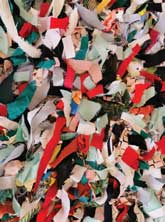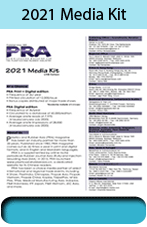Holiday couture: going the full nine yards for sustainability
Consumers are putting a premium on sustainability, signalling the fashion industry to adopt circular solutions to utilise the value of old garments and transform them into new goods, says Angelica Buan in this report.

This the season for gift giving – and creating more plastic waste! In the US alone, according to the US Environmental Protection Agency (EPA), about 25% or 25 million tonnes of rubbish, consisting of packaging materials, ornaments, disposable cutleries, and more, is generated during Thanksgiving and New Year’s Day. The Christmas season is not an exemption as shoppers resort to retail therapy with presents, ornaments and festivity essentials, with the likelihood to produce more waste from packaging materials alone.
E-commerce takes a front step
The rise of e-commerce, especially during the Covid-19 pandemic lockdown, has highlighted sustainability in the production of consumer goods and in the purchasing decisions of the consumers. A recent study by the IBM Institute for Business Value, pulsing over 12,500 consumers in October across Brazil, Canada, Germany, India, Mexico, Spain, the UK and the US, found that global consumers are mindful of sustainability of brands when shopping online.
In the UK, producer responsibility of retailer and brands is a key takeaway in a study conducted by waste management provider Biffa, which means that all eyes are on products that pitch fewer plastics or contain recycled plastics and recyclable materials.
The string purses may be tighter this year, given the pandemic, but funds saved from deferred travel plans and other activities on concerns over health, finances and safety, are likely to be channelled to buying holiday gifts according to a report by Deloitte. It forecast an increase of 25% to 35% in 2020 holiday e-commerce sales, expected to generate between US$182 billion and US$196 billion, compared with the same period in 2019.
Wish list for recyclable apparel
Apparel is a holiday shopping staple, and while sales this year may not be as glitzy as before the Covid-19, fashion brands continue to dish out new designs to cut through the competitive retail space. But simply introducing fashionable trends no longer works in keeping consumers’ loyalty to a brand. The fashion industry needs to change its current clothing system, which a 2017 report from the Ellen McArthur Foundation described as “linear”.
To produce garments that will only be used for a short period of time, huge amounts of non-renewable materials are consumed, including lots of water that is required in the production, the report said.
The industry also contributes to the huge amounts of fibre wastes: 87% of the total fibre input used for clothing is incinerated or disposed of in landfills.

Furthermore, the industry also accounts for 10% of global carbon emissions and it produces 20% of global wastewater, according to the United Nations Environment Programme (UNEP) data. It said that a pair of jeans consumes 3,781 l of water, from the production of the cotton to the delivery of the final product to the store, producing carbon emissions of around 33.4 kg. What’s more, synthetic-fibre clothes when washed release 500 million tonnes/year of plastic microfibres into the oceans.
Of the increasing volumes of unused or discarded garments, less than 1% are recycled into new garments, the experts tipped off.
An iconic solution in recycling garments
In response, the fashion industry has risen up to the occasion by developing and adopting circular solutions, such as garment to garment recycling and use of fibres from recycled plastics, to achieve the so-called new textile economy, where new materials that are recyclable and made for durable clothing are adopted to ultimately help in reducing pollution.
Swedish fast fashion company H&M, which in 2013 became the first fashion retailer to roll out a global garment collecting programme, has recently offered a garment-to-garment recycling system, Looop, for its customers in Sweden to transform unwanted garments into new fashion items for a fee.

Looop is created by the non-profit H&M Foundation, together with research partner HKRITA (The Hong Kong Research Institute of Textiles and Apparel) and Hong Kong-based yarn spinner Novetex Textiles. The recycling service, which debuted in one of H&M's stores in Stockholm in October, gives customers an up-close view of the container-sized machine that dissembles and assembles old garments into new ones.
The process involves cleaning the garments, shredding them into fibres and spinning it into new yarn, which is then knitted into new fashion products. Some sustainably sourced virgin materials might be added during the process, H&M explained. Because the system uses no water and no chemicals, it has a significantly lower environmental impact than when producing garments from scratch.
By 2030, the company is set to making all its materials either recyclable or sourced in a more sustainable way.
Discarded bottles spun into new life
Every minute, 1 million plastic drinking bottles are bought, and about the same amount will be discarded after use, according to UNEP.
Recovering billions of waste bottles is a feat taken up by US-headquartered synthetic yarns firm Unifi, which has set a goal of transforming 30 billion bottles by 2022. It is on track to that goal as it has already transformed more than 20 billion PET bottles to date via its Repreve platform of recycled performance fibres. This milestone, according to Unifi, is equivalent to diverting from landfills 156 plastic bottles per each of the estimated 128 million US households and transforming these into Repreve fibres to make fabrics for apparel, upholstery, automotive and industrial applications. The firm says more than 500 global brand and textile partners are already adopting Repreve fibres.
Meanwhile, Thailand-headquartered integrated PET materials firm Indorama Ventures has been awarded a blue loan of US$300 million from the International Finance Corporation (IFC) to undertake the recycling of 50 billion PET bottles/year globally by 2025. The funding will help Indorama increase its recycling capacity in Thailand, Indonesia, Philippines, India, and Brazil: countries which are grappling with mismanaged waste and serious plastic waste in the environment. A blue loan is an instrument whereby the funds raised are certified and tracked exclusively for projects that support a Blue Economy – i.e. sustainable use of ocean resources for economic growth. Indorama Ventures is aiming for a minimum of 750,000 tonnes/year of rPET globally by 2025.
Read more...
(PRA) Subscribe to Get the Latest Updates from PRA Please click here
©2020 Plastics and Rubber Asia. All rights reserved.

©2020 Plastics and Rubber Asia. All rights reserved.
Home Terms & Conditions Privacy Policy Webmail Site Map About Us














